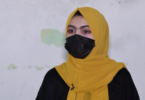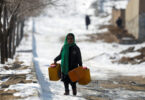KABUL (CNN): Health care in Afghanistan has literally collapsed in a matter of months, disrupted by conflict and starved of foreign assistance, according to UN agencies and NGOs working in the country. Thousands of medical staff have not been paid in six months and clinics have no medicine or equipment.
The NGO Save The Children says the break down of Afghanistan’s health system will result in the deaths of thousands more children under the age of five every month as winter approaches.
The absence of health care for a majority of Afghans — especially outside the cities — is part of a perfect storm of crises descending on the country.
There are chronic food shortages. More than 12 million Afghans face hunger and depend on food aid, according to the UN; malnutrition is rising sharply.
There is an acute shortage of cash, making it difficult for NGOs still working in Afghanistan to pay salaries and buy supplies.
More than 600,000 Afghans have been displaced this year. According to UN figures, 80% of them are women and children.
Coronavirus infections are rising again, with the vast majority of the population still not fully vaccinated. A lack of reliable figures and very little testing make the impact of the pandemic difficult to gauge. According to the UN, before August of this year, 2.2 million Afghans had been vaccinated against Covid-19.
The UN Office for the Coordination of Humanitarian Affairs (OCHA) said this week that aid agencies in Afghanistan “are in a race against time to deliver life-saving aid to crisis-affected people and preposition supplies ahead of winter.”
Mary-Ellen McGroarty, country director for the World Food Program, told CNN that she had “never before seen a crisis unfold at this pace and scale.”
“We are witnessing a new depth of destitution as the drought and the economic crisis drives up food and fuel prices,” she said.
Catastrophe ahead
One expert who has seen all this unfold is Bahman Shahi, who works for the health and education consultancy ACASUS in Afghanistan. He has just finished a two-week tour of clinics in the south of the country and paints a grim picture.
Shahi says his tour, which focused on Helmand, Kandahar and Kabul provinces, revealed a collapsing health system. At the majority of the centers he visited, there were no patients at all, nor health staff. He also found an acute shortage of basic equipment, supplies and medication. “The very basic things are just not there,” he told CNN.
Many people, he says, are not even aware that the coronavirus exists.
Shahi says the worst affected are the poorest, who can’t afford to travel to private health facilities in the cities. He estimates that this amounts to about 11 million Afghan citizens, some of whom have returned to rural areas because there are no jobs in the city.
UN agencies, assisted by NGOs such as the Global Fund, are trying to plug gaps in the absence of foreign assistance, which dried up when the Taliban took control of the country. The World Bank, the United States, the European Union and others suspended aid through the Afghan Health Ministry pending guarantees from the Taliban.
World Bank-administered funding for Afghanistan’s nationwide health program, known as the Sehatmandi project, came to a halt in August. Now somewhere between 80 and 90% of the 2,300 facilities remain functional in any way, according to the World Health Organization and Save the Children. Two-thirds have run out of essential medicines, according to OCHA.
The EU has promised a new aid package, and a UN conference in Geneva last month raised pledges of $1 billion in assistance. But with the onset of winter weeks away, little of this aid has reached those most in need. OCHA said this week that the urgent appeal launched last month for $606 million for the most vulnerable in Afghanistan remains only 35% funded.
The Global Fund, which funds campaigns against H.I.V., malaria and tuberculosis, and the UN Development Program are trying to bridge part of the funding gap, providing $15 million to help keep some of the 2,300 primary health facilities nationwide open. The UN special envoy to Afghanistan, Martin Griffiths, announced a further $45 million in emergency funds for health care.
Peter Sands, executive director of the Global Fund, says that the funding will help “ensure the most vulnerable populations — particularly women and girls — continue to have safe access to essential health services.”
But such measures are, at best, papering over the cracks — especially, Shahi says, as the international community is reluctant to pass funds through the Taliban government.
Among the most vulnerable to Afghanistan’s health crisis are women and children. Every two hours an Afghan woman dies in childbirth — a statistic horrifying enough even before the impact of the current health care crisis is felt.
Refugees International, in a report published this week, says that with the Taliban in charge, women’s mobility and their right to directly receive resources (such as food aid or cash assistance), as well as their ability to independently access health services are all in jeopardy.
Devon Cone, who wrote the report, tells CNN that “with the healthcare system itself struggling to survive, coupled with restrictions on women working, women and girls have very little means to access any basic, essential healthcare.”
Cone adds: “If nothing is done to stop the trajectory we are on, the consequences will be disastrous for Afghan women.”
While the Taliban leadership in Kabul have said that women can continue to work in the health sector, Cone says local officials don’t always follow that guidance. “And in places where there are no female health professionals then women and girls are not receiving healthcare.”
The OCHA says 68% of Afghan women surveyed said they faced challenges in accessing health facilities.
Specter of malnutrition
Millions of severely malnourished children urgently need treatment, with many at risk of dying if they are not treated immediately, according to Save the Children.
“When our health team resumed its services in Kandahar in September, nearly half of all children they assessed for malnutrition on their first day of work were acutely malnourished,” said Dr. Staniczai Mansoor, Save the Children’s Senior Health Technical Advisor in Afghanistan.
“Currently, two million acutely malnourished children under the age of five do not have access to treatment.”
Over the last twenty years, the health of Afghans improved by almost every metric. Maternal and child deaths fell by more than 50% and life expectancy for men and women increased by about 10 years.
But those gains began to tail off before the Taliban took power.
The health crisis gathered pace as conflict spread, supply routes were disrupted and a new wave of the coronavirus spread. It was further aggravated by the previous government’s failure to pay the wages of health workers for months. Shahi says disputes with the World Bank and NGOs over contracts were partly to blame.
Even before the Taliban takeover, according to Save the Children, it was expected that half of all children under five and a quarter of pregnant women would need life-saving treatment for malnutrition.
One senior official with an NGO, who asked not to be identified while speaking about this sensitive subject, said that the Taliban have replaced many of the health professionals in Kabul and at provincial level — making the delivery of services even more difficult. But the official says that at least in some areas, former health directors are being consulted by the Taliban.
Agencies such as WHO have begun airlifting essential medical supplies into Afghanistan again. But it’s a race against time. According to Dr. Luo Dapeng, WHO Country Representative in Afghanistan, “access to health for Afghans is falling further out of reach just as winter approaches.”






